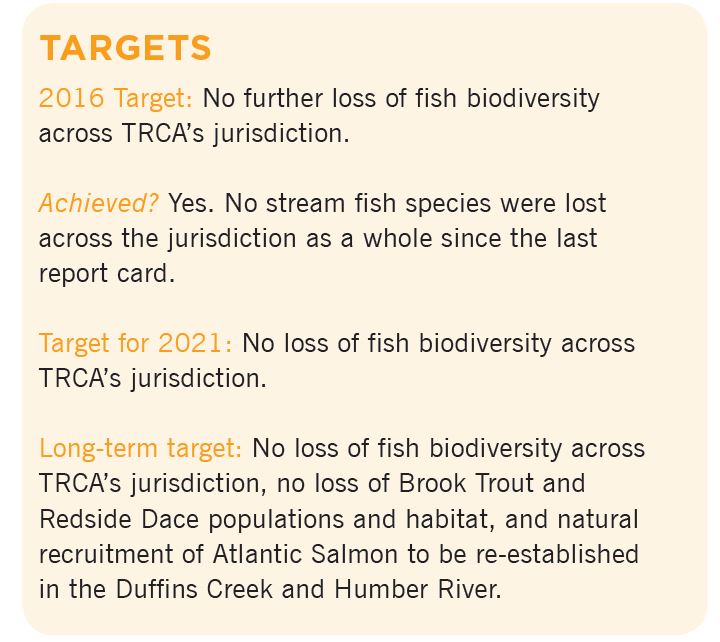TRCA’s Environmental Monitoring team recently did a deep dive on The Living City® Report Card 2016 and its conclusions. Here’s their breakdown of the key takeaways.
Toronto and Region Conservation recently published the The Living City® Report Card 2016: a progress report on environmental sustainability in the Toronto region.
The report outlines how well agencies in the Greater Toronto Area are working together to achieve sustainability goals for carbon, air quality, waste, water, land use and biodiversity. These goals were set out when the first The Living City Report Card was released in 2011. The intent is to evaluate the progress made toward reaching these goals every five years.
| READ: The Living City® Report Card: Grading the GTA’s Environmental Health |
Read or Download The Living City® Report Card:
The Current Situation
Short and long term targets for 15 indicators were evaluated in The Living City Report Card 2016. Toronto and Region Conservation contributed quantitative analysis and expert opinion to assess multiple indicators of water, biodiversity and land use and worked with other agencies to report on air quality, carbon and waste. Here are the results of those efforts:
The Role of Environmental Monitoring
There are many efforts that contribute to a sustainable region, from planting trees to improving stormwater management and green infrastructure. But how do we know if these efforts are producing positive changes? The answer is long-term data collection. Without these data sets, evaluation of the indicators is not possible. For example, TRCA’s Regional Watershed Monitoring Program has been collecting long-term data since 2001 on water quality as well as communities of birds, fish, frogs and plants.
Water Quality
Since 2002, TRCA has partnered with the Ontario Ministry of the Environment and Climate Change and the City of Toronto to monitor surface water quality monthly across the region’s watersheds. The water quality grab samples are analyzed for a standard suite of water quality parameters, including metals, nutrients and bacteria.
For The Living City Report Card, these data are used to evaluate Water Quality using a Water Quality Index Score for each of the monitoring sites in Toronto region watersheds.

Fish Communities
Each of TRCA’s nine watersheds are surveyed for fish communities and habitat features every three years. For example, 2016 marked the fifth time fish communities and habitat were sampled in the Etobicoke Creek and Humber River watersheds. In 2017, monitoring will shift to the Don River, Mimico Creek, Highland Creek, Petticoat Creek, and Frenchman’s Bay watersheds.

For the Living City Report Card, these data are used to evaluate the health of fish communities in streams by measuring the number of native fish species collected in comparison to the number of native species one would expect to find in a healthy stream.

Terrestrial Biodiversity
TRCA has implemented long-term monitoring in forest, wetland and meadow habitats region-wide to measure how species and vegetation communities are responding over time to impacts from surrounding land use activities.
All flora and vertebrate fauna species, as well as vegetation communities, found in the region have been assigned a rank based on scores that measure their local abundance as well as their sensitivity to development impacts. The goal of this scoring and ranking system is to proactively identify species at risk of becoming rare, threatened or locally extinct. Based on this system, 693 species in TRCA’s jurisdiction are currently designated as Regional Species of Conservation Concern.
For the Living City Report Card, these data are used to evaluate the regional terrestrial biodiversity based on the combined scores for three indicators: (1) native forest and wetland plants, (2) forest, wetland and meadow birds, and (3) frogs.

What Needs To Be Done
In the last five years, since the first The Living City Report Card was released, the Toronto region has made some important improvements, maintained past progress in other areas, and seen other indicators decline. Despite many gains, overall progress toward a sustainable Toronto region is slow. The hope moving forward is that increased collaboration will accelerate the impacts made.
| READ: Greening the GTA: Collaboration is Key |

Through scientific data collection, TRCA’s Environmental Monitoring and Data Management team tells the stories about the changes affecting the natural areas and watercourses within our regions. For more information, please visit our website, follow us on Twitter, subscribe to our Monitoring Matters e-newsletter, or visit our YouTube playlist.
